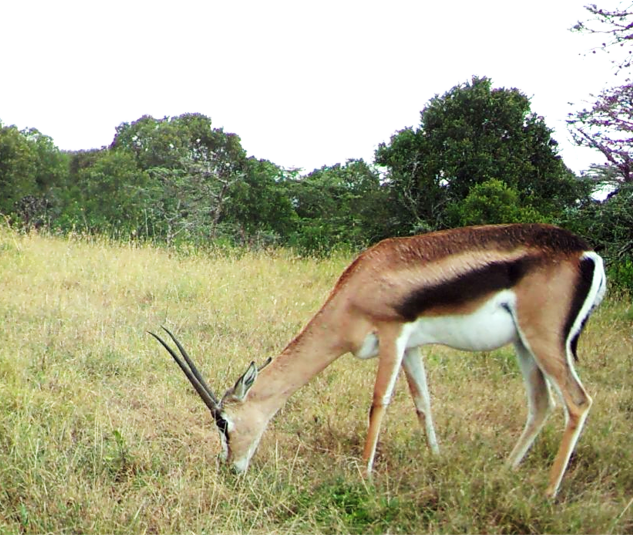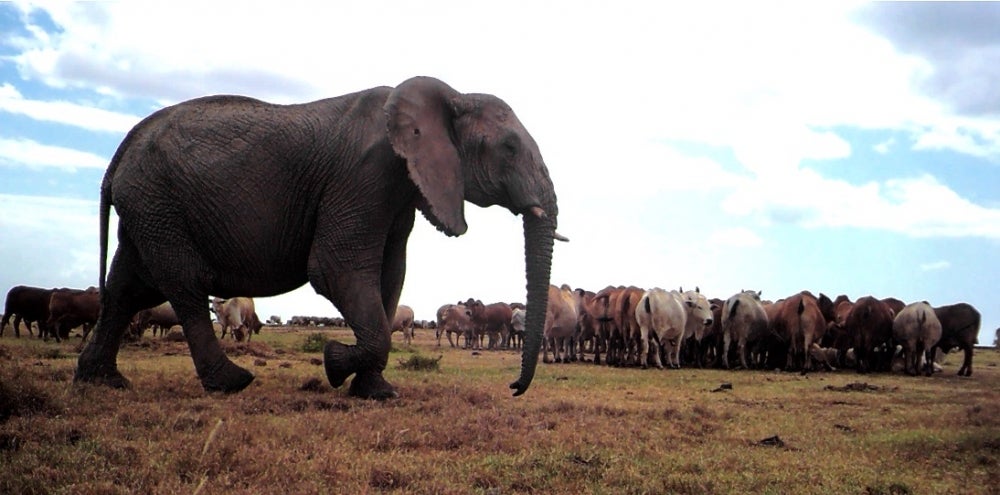
Wildlife’s Worm-Wide Web

Many of us try to repress the thought of them, while others have come to accept them. Whatever your take on parasites is, they can tell scientists a lot about ecology, health and the environment.
For instance, consider which animals share parasites. It’s a simple question with many implications for food webs, rare species and even environmental change. It’s also critical to understanding disease transmission in a world where human and animal hosts are increasingly interconnected. Answering this question is tricky, though, particularly when research involves endangered and threatened species.
An international study led by a UC Santa Barbara researcher offers a promising solution. Using DNA from large herbivore dung, scientists uncovered an entire network of gastrointestinal parasite sharing among 17 wild and domestic herbivore species. The paper, published in the Proceedings of the Royal Society B, sheds light on patterns of parasite diversity at the wildlife-livestock interface. In particular, the authors found that gastrointestinal parasites tend to infect hosts with similar gut types and evolutionary history, and that domestic animals are central players in this network.
Lead author Georgia Titcomb was a graduate student at UC Santa Barbara when she first started getting her hands dirty with giant mammal poop. Working on her dissertation, she wanted to understand how large, wild and domestic animals might be sharing parasites at water sources where they gather. But she grew increasingly frustrated using typical methods of manually identifying and counting parasite eggs. “I’d pore over the microscope and see eggs that all looked exactly the same,” she said. “There was no way to tell if the amorphous microscopic oval I found in cow poop could be capable of infecting an antelope.”
Looking for a better way, Titcomb reached out to co-author Rob Pringle at Princeton University, who had used DNA in herbivore dung to figure out their diets. “I was inspired by their paper,” recalled Titcomb, who is joining the faculty at Colorado State University. “I wondered: What if we could adapt this method to discover the immense diversity of parasites in these herbivores?” Perhaps it could reveal predictable patterns of parasite diversity and sharing.

Grant's gazelles are known to have high rates of nematode infections. Many parasitic nematodes are transmitted when an animal eats vegetation that is contaminated by the dung of another infected host.
Photo Credit: TITCOMB, HULKE & MANTAS
“We wanted to understand the factors that influence the composition and similarity of parasite communities in different host species,” Pringle said, “as well as get a sense for who might be sharing parasites with whom.”
The team used DNA metabarcoding — a technique that amplifies a short strand of DNA in a sample and matches it to sequences in a genetic database — to figure out the presence and diversity of parasites in 17 large herbivore species found at Mpala Research Centre in central Kenya. “Having such a rich diversity of herbivores that all overlapped in one study location allowed us to investigate a wide range of factors that might explain their parasite infections,” Titcomb said.
The authors tested several variables — like a host’s body size, diet and social group size — and found a few key patterns. “The most important factor was the evolutionary history of the host,” Titcomb explained. “More closely-related hosts had more closely-related parasites.” Additionally, the structure of the host’s gut — the parasite’s habitat — could determine the community of parasites found there.
Mammalian herbivores fall into two main groups: those that digest plant matter in their foregut, and those that digest plant matter in the hindgut. Foregut fermenters — like cows, antelopes, buffalos and giraffes — are highly efficient at extracting nutrients from plants because they have an intricate stomach. The authors suspected that these multi-chambered stomachs may provide a lot of habitat complexity for gut parasites. As a result, these animals might have a different array of parasites than hindgut fermenters — such as zebras, donkeys, elephants and warthogs — which have a long colon where they absorb most nutrients.
Why are different parasites found in different areas of the gut? “One reason could be that the digestive process involves a really striking variation in acidity as well as microbes,” Titcomb said. Parasites must be adapted to living in these conditions, so they likely specialize in different areas of the gastrointestinal tract.
Animals that have similar gut types also tend to have similar evolutionary histories — and therefore might share several other factors that affect parasites, like immunity — so it is very challenging to separate the role of gut type from host relatedness. That said, the authors found genetically similar parasites in very different groups of animals — like warthogs, zebras and elephants — so they suspect gut type is responsible for a considerable amount of this variation.
One conclusion the authors hadn’t expected turned out to be rather important. “We found that several livestock species were really embedded in this parasite-sharing network,” Titcomb said. “Camels, cows and donkeys each shared parasites with multiple wildlife species. Despite being dewormed at weaning, cows still shared parasites with at least eight other species.”
Accounting for the important role livestock play in these networks is crucial to planning for the future. “Worldwide, large-mammal populations are declining and increasingly being displaced by livestock,” Pringle said. “The parasites of these animals are important influences on their health and fitness, which is a potential problem for conservation and for human livelihoods insofar as wildlife can transmit disease to livestock.”

Watering holes bring together wildlife and livestock alike, enabling parasites to move between hosts.
Photo Credit: GEORGIA TITCOMB ET AL
The authors think their findings will be important for livestock management. A proper understanding of the factors that influence these parasite networks is crucial for designing effective conservation plans and anticipating and managing disease outbreaks, Pringle added.
For example, it’s important to understand the extent to which camel and cattle are sharing parasites with wild herbivores. The team found that 90% of camels were infected with at least one parasitic nematode species. Camels are increasingly replacing cattle in the study area due to their tolerance to drought, and they were one of the most important species in the parasite-sharing network.
Titcomb also noted that these are still early stages, and there is a lot more work to do. “We only looked at one facet of the parasite world,” she said, “albeit an important one for herbivores. But there are many other parasite groups to look at too.”
The authors also point out that the metabarcoding method is not perfect. “There are many aspects to consider when using these techniques, which are constantly evolving,” Titcomb said. “Additionally, we aren’t yet able to reliably quantify the intensity of an infection, which is important for animal health and for detecting potential superspreaders.”
In the future, Titcomb expects that parasite DNA metabarcoding will be an important tool for parasitologists and disease ecologists as they study infections across changing landscapes. “I think the coolest thing is that we can now take this teeny tiny bit of DNA, totally non-invasively, and be able to unravel an entire world of parasites cheaply and efficiently for hundreds of samples,” she said. This provides unprecedented power to link animals by their shared parasites, to study them over time and to look at how these dynamics change in different contexts.



